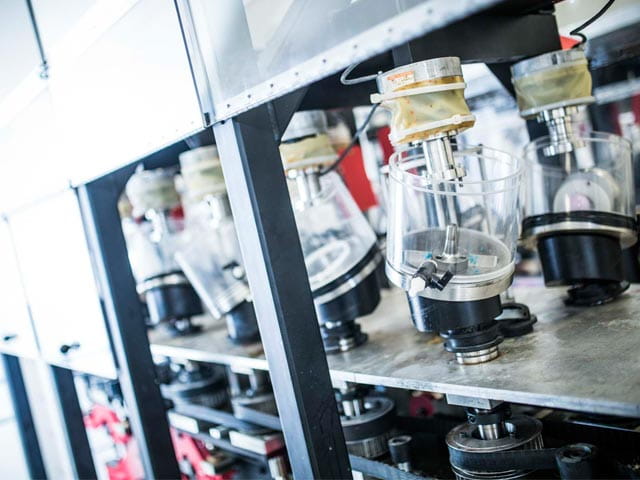Do's and Dont's of Medical Device Mechanical Testing
Mechanical testing laboratories break stuff. Day in and day out, fatigue machines run to give orthopaedic device designers the answers they need to achieve success.
Although mechanical testing is only a small component in the product development life cycle a launch of an orthopaedic device into the market, it is a critical one. Whether the device design firm is a one-person start-up or a multi-million-dollar giant in the industry, the outcome of the device testing can make or break (no pun intended) the product’s chances for getting to market.
Orthopaedic device manufacturers should understand how to get the most out of device testing plus some design tricks for the best value. Understanding the intricacies and the best practices of testing will determine an OEM’s success in the mechanical testing of its product. Manufacturers could take years of trial and error to gain this knowledge, so it is important to consider these dos and don’ts when testing orthopaedic devices, as well as for finding a long-term testing partner or working with the firm’s internal laboratory.
Do's
Do Use an Accredited Lab.
The first priority in the orthopaedic device industry is quality. FDA is scrutinizing quality standards at unprecedented levels for every step of the device development process—and mechanical testing is no exception. And at the end of the day, FDA holds the OEM responsible for deficiencies in its suppliers’ quality practices.
To protect the investment, make sure that the laboratory has passed the rigorous standards set forth by an independent accreditation body, such as the American Association for Laboratory Accreditation (A2LA) or the National Aerospace and Defense Contractors Accreditation Program (NADCAP). The accreditation process is a tough one. An A2LA laboratory is audited on scheduled intervals to ensure that its quality assurance and quality control standards are in place to offer high-quality, independent results for tests. In addition, consider whether the testing lab adheres to ISO 17205, “General Requirements for the Competence of Testing and Calibration Laboratories.” Compliance with a calibration standard is a positive sign and ensures the validity of the designer’s results.
Do Join ASTM and Make Your Voice Heard.
A device manufacturing company has the choice to be a leader or a follower in the industry. Join the American Society for Testing and Materials (ASTM) International and attend an F04.25 subcommittee meeting to witness and participate in the specification development and renewal efforts. The semiannual ASTM meetings provide a superb opportunity to network within the industry and to answer any questions on medical device testing specifications and how they apply to a firm’s specific devices. Most importantly, however, getting involved with ASTM provides the opportunity to push for the necessary evolution of test specifications that affect an OEM’s products.
Do Finite Element Analysis (FEA) Evaluations Prior to Testing.
Finite Element Analysis (FEA) is a mathematical technique for analyzing stress points on a given design. Many laboratories recommend that medical device manufacturers perform FEA evaluations on their devices before testing or making prototypes. Although FEA has shortcomings—the author’s experience shows a 65% accuracy rate—it’s better than nothing. Experimenting with virtual designs is always more cost-effective than prototyping hundreds of assemblies that cost thousands of dollars. Failure should be expected and defined prior to testing so that the outcome can be anticipated. Everything breaks at some point—however, a device should aim for mature failure.
In addition to failure methods defined in ASM, vol. XI, the manufacturer and possibly the lab should research failures modes and mechanisms based on a variety of sources. Sources can include internal data such as complaints and failures, or they can be external, e.g., medical device reports, recalls, material issues, and customer inputs.
Do Test to Worst-Case Scenarios.
A medical device manufacturer tests a middle-size version of its device, submits the test findings along with its 510(k) paperwork, only to have FDA require additional testing because the most extreme circumstances were not accounted for. This mistake happens freqeuntly—and the price of such a mistake can be a missed product launch, or even a redesign. Test to a worst-case condition within the sizes of a device to qualify the grandfather of the entire design scale.
Do Look for a Lab that Can Help with Custom Testing.
ASTM test specifications are just that—specifications for a particular test, trying to achieve a specific outcome. But what happens when a product is so innovative that it does not quite fit into a prepackaged test plan? Testing to a specification that is not appropriate for a product or does not provide relevant and usable data for FDA is a waste of time and money.
OEMs might find it necessary to deviate from a particular test protocol or specification to obtain the desired information. There are many reasons for such a deviation, including speed, load, test mounting, etc.
When searching for a testing partner, look for one that has experience developing customized protocols and can develop customized machinery or fixturing to support the endeavor. This flexibility is especially crucial for start-up device companies. A key point to remember, however, is that the final report from the laboratory will note the deviations from test specifications or customizations, so be prepared to provide an engineering justification with FDA submissions.
Do Match the Device with the Application Life Span.
Things break all the time, and in the best cases, the device designer plans for that day. For example, car transmissions are designed for certain periods of usefulness (e.g., 100,000 miles or 10 years). Medical device design should have a well-defined end-of-life date as well. A properly matched mechanical impedance system will theoretically see all components break at once when a device has reached its intended end of life.
Do Look for a Lab that Regularly Performs Failure Evaluations and Root Cause Analysis.
When a design fails and does not achieve the desired results, the cause could be one or more of the following:
- Design shortcomings (the product does not perform to expectations due to a structural weakness below minimum performance values).
- Material defect (wrong material, poor thermal treatment, contamination, etc.).
- Manufacturing defect (poor surface finish, dimensional error, etc.).
- Poor assembly technique (stripped screws, insertion tools, etc.).
- A lab that is experienced in failure evaluation uses proper metallographic techniques to determine the root cause of the failure.
Do Have a Goal.
This sounds simple, but for many OEMs, defining exactly what they wish to achieve is a challenge. After all, how can you answer a question or solve a problem if you don’t know what the question or problem is? The manufacturer should ask itself, “What are we trying to achieve with our testing?” and then share this information with the lab. Don’t forget to sign a nondisclosure agreement before explaining the situation to the testing laboratory.
Also remember that regulatory agencies (FDA, SFDA, ANVISA, etc.) have a common goal to protect their citizens from substandard medical devices. As new devices are developed and become more refined, the burden of proof is on the device owner to demonstrate equivalency (at a minimum) with a similar device that has already been approved. Innovative designs and materials continue to elevate mechanical performance requirements.
Do Read ASTM E177 to Understand Test Precision and Bias.
ASTM E177 is the specification for “Standard Practice for Use of the Terms Precision and Bias in ASTM Test Methods.” In the text, r is used to refer to repeatability conditions. ASTM defines repeatability conditions as “conditions where independent test results are obtained with the same method on identical test items in the same laboratory by the same operator using the same equipment within short intervals of time.” It could also be considered that test results are measurements and that a laboratory is a facility. Reproducibility (R) is defined by ASTM as “conditions where test results are obtained with the same method on identical test items in different laboratories with different operators using different equipment.”
Expect repeatability and reproducibility (r&R) with common tests. A medical device designer needs to understand how these terms can affect a device to ensure valid results.
Don’ts
Don’t Forget to Read the Specifications.
The test lab is an expert on testing—not on the product. Don’t blindly rely on it to know how and what to test. Use the lab for recommendations and suggestions, but the designer should read the specifications and applicable guidance documents to understand what needs to be tested and—more importantly—why it needs testing.
ASTM International testing standards are available to everyone. This is one of the few cases in the medical device product development cycle where the playing field is level, whether the company is a blue chip or a start-up firm. All devices are held to the same standards.
Don’t Test Out of Order.
Perform static performance tests before fatigue tests. Static tests provide insight into fatigue failures. A designer may realize after static testing, which is considerably less costly than dynamic testing, what the product needs before further testing can be performed. This step could save the manufacturer a substantial amount of money and precious time.
Don’t Be Afraid of Failure.
Thomas Edison said about his plethora of prototypes for the electric bulb, “I have not failed. I’ve just found 10,000 ways that won’t work.” Not every test will pass, but remember—knowledge is gained from every failure. When developing medical devices, as in many industries, sometimes it is a process of elimination.
Don’t Design in a Fish Bowl.
If this is a designer’s first rodeo with FDA, consider hiring a consultant with medical device approval experience—a trait that is especially vital with the ever-changing requirements of FDA. In addition to the expertise and experience a consultant can offer in developing 510(k) submissions and with navigating the process from start to finish, regulatory consultants already have established communications with FDA. It is their job to know what is getting approved and what is not, and what the regulatory agencies are looking for in terms of device performance.
Don’t Overdo Testing “Just to See What Happens.”
Testing takes time, effort, and funding. Have a clear idea of what to accomplish and do not perform more than is needed, whether that be specific tests, loads, or runs. In all likelihood, FDA will request more testing after the initial submission, so don’t do more than is required unless it is justified. Otherwise, it is simply stretching out the process, and testing will likely have to be redone down the road.
If management is curious to test, “just see what would happen,” consider investing in a fatigue frame for ad hoc, in-house testing. In-house engineers can test prototypes, and then outsource the official ASTM testing to an accredited laboratory.
Don’t Forget About Lead Time.
In the orthopaedic implant industry, just a few weeks of delay in mechanical testing can lead to severe approval delays. Such delays could slow time to market, which could mean millions in lost revenue to a company. Look for a lab that has the capacity to run dynamic tests concurrently and deliver final reports quickly.
Conclusion
Although mechanical testing is just one part of bringing a medical device to market, it is an important one. As in every other aspect of the medical device development process, begin with the end in mind.
If the designers, engineers, and regulatory employees understand the guidelines for testing and the objectives of that testing project, they can work with the test lab on a clear roadmap for accomplishing those goals. If some homework is done before testing, it can lead to a greater chance of capturing the data needed for a successful product. Up front work can save precious time and capital for orthopaedics firms.
Find related Resources

